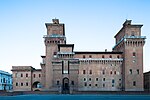Ferrara Cathedral
12th-century Roman Catholic church buildings in ItalyBurial places of popesCathedrals in Emilia-RomagnaGothic architecture in Emilia-RomagnaMuseums in Ferrara ... and 5 more
Religious museums in ItalyRoman Catholic cathedrals in ItalyRoman Catholic churches in FerraraRomanesque architecture in Emilia-RomagnaSites of papal elections

Ferrara Cathedral (Italian: Basilica Cattedrale di San Giorgio, Duomo di Ferrara) is a Roman Catholic cathedral and minor basilica in Ferrara, Northern Italy. Dedicated to Saint George, the patron saint of the city, it is the seat of the Archbishop of Ferrara and the largest religious building in the city. The cathedral stands in the city centre, not far from the Palazzo Comunale and the famous Castello Estense and is connected to the Archbishop's Palace by a covered passage.
Excerpt from the Wikipedia article Ferrara Cathedral (License: CC BY-SA 3.0, Authors, Images).Ferrara Cathedral
Piazza della Cattedrale, Ferrara Giardino
Geographical coordinates (GPS) Address External links Nearby Places Show on map
Geographical coordinates (GPS)
| Latitude | Longitude |
|---|---|
| N 44.835508333333 ° | E 11.620144444444 ° |
Address
Cattedrale di San Giorgio Martire
Piazza della Cattedrale
44141 Ferrara, Giardino
Emilia-Romagna, Italy
Open on Google Maps











